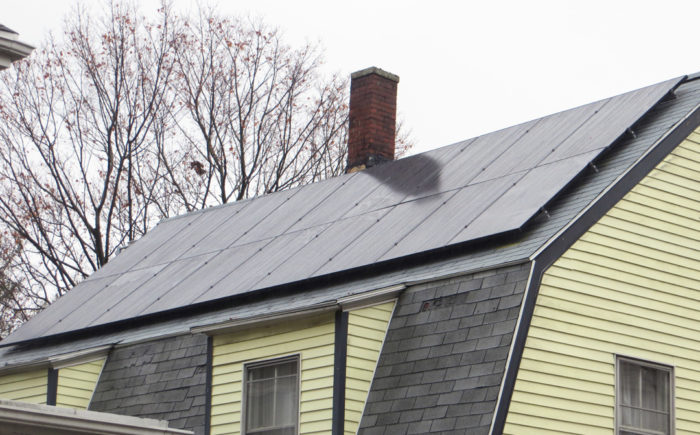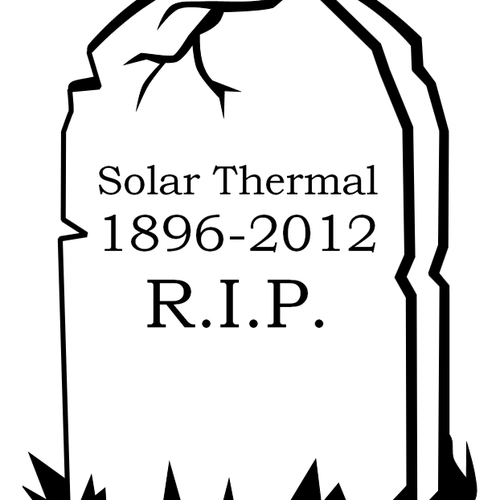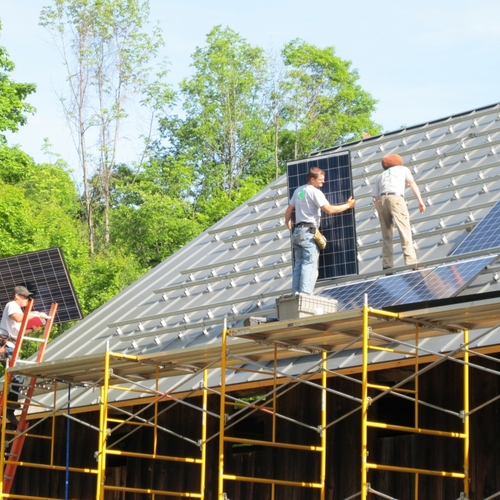
Image Credit: Image #1: Peter Holladay
UPDATED on December 4, 2016 with PV system production data for the first year of system operation.
Compared to a photovoltaic system, a solar hot water system yields very little energy per dollar invested. I presented that argument in a 2012 article called “Solar Thermal Is Dead.” Two years later, in 2014, an economic comparison between these two solar technologies showed a stronger tilt than ever before in favor of PV, leading me to write a follow-up article called “Solar Thermal Is Really, Really Dead.”
According to the latest available (2009) data from the Residential Energy Consumption Survey (RECS), the average U.S. household’s energy expenditure for domestic hot water is $280 per year. Since a solar hot water system can be expected to provide about 63% of a home’s hot water — the rest being produced by a backup system during cloudy weather — it’s hard for a solar hot water system to save more than $176 per year (about $15 per month). If the solar hot water system costs $9,000 — a reasonable assumption — the investment in solar equipment will yield only 2% per year. That’s less than the current yield on a U.S. 10-year bond.
This analysis overstates the actual yield of an investment in a solar thermal system, however, for several reasons. First, this analysis ignores a solar thermal system’s ongoing maintenance costs; and second, when a U.S. bond matures, you still have your capital — whereas when a solar thermal system wears out, it’s headed to the landfill or scrap heap.
High repair costs
A third article on solar thermal systems — Solar Hot Water System Maintenance Costs — discussed the trials and tribulations experienced by my brother Peter and his wife Elana in Massachusetts. Over the past…
Weekly Newsletter
Get building science and energy efficiency advice, plus special offers, in your inbox.

This article is only available to GBA Prime Members
Sign up for a free trial and get instant access to this article as well as GBA’s complete library of premium articles and construction details.
Start Free TrialAlready a member? Log in















6 Comments
Priorities...
I notice that the PV went up before the lower roof was replaced. Good to see that Peter and Elana have their priorities straight. ;-)
Over paying for PV...
I'm still amazed at the crazy SREC prices in places like Mass, NJ, D.C., etc. It's like being able to walk down the street to a store where they're handing out freshly minted dollar bills. While places like Austin, TX are signing utility-scale solar power-purchase agreements for under $0.04/kWh ...Massachusetts has committed itself to paying a minimum of $0.189/kWh for SRECs for another decade...and they don't even get the energy for that price...the PV system owner still gets to keep the energy!
Response to John Semmelhack
John,
You're right: only the roofing on the upper slope of the gambrel was replaced. One step at a time...
Your second comment raises several important policy questions:
1. Should society invest money to de-carbonize the grid?
2. If the answer to that question is yes, does it make sense (at this point) to encourage more PV installations?
3. If the answer to Question 2 is yes, what is the best way to structure the incentives to encourage PV?
In light of our current climate change crisis, I think that in the U.S., the answer to Question 1 is yes. I think that our attempts to de-carbonize the grid have been timid and slow -- too timid and too slow to achieve the targets that we need to hit to prevent an environmental and economic catastrophe. That's scary.
Concerning Question 2: PV is now a very minor contributor to electricity production in the U.S., in every state but Hawaii. In light of the slow pace of PV adoption in the U.S. (compared, for example, to Germany), I think that a strong argument can be made in favor of investments designed to encourage a more rapid adoption of PV. As PV installations increase, these incentives will need to be dialed back. But Massachusetts is still years away from having too much PV.
Concerning Question 3: Any discussion of PV incentives needs to start by acknowledging that most countries in the world (including the U.S.) provide several kinds of subsidies designed to encourage the use of fossil fuels. We don't have a level playing field for renewable energy.
There will always be those who argue that PV incentives flowing to middle-class and upper-class homeowners might be more efficiently spent -- for example, by encouraging the construction of large utility-owned "solar farms" rather than rooftop PV. It's not clear, however, that this argument has merit. There's plenty of opposition to the "solar farm" route.
All I know is that PV adoption in the U.S. is still too slow -- and that in many areas of the U.S., ignorant politicians, ignorant regulators, and stubborn utility executives are part of the problem. (More of a problem that overly generous incentives for homeowners who install rooftop PV.)
An amazing investment indeed
As an owner of a recently installed 5.5kw PV system in Massachusetts, I whole-heartedly agree with your conclusion that "any Massachusetts resident who is saving money for retirement is unlikely to find a better legal investment than a rooftop PV system". It has been a fantastic experience in my first 18 months of ownership. Between the savings on my electric bill and the SRECs, every kwh that I produce is effectively worth about $0.48/kwh. The payback period for me should be less than 4 years, Amazing!
I have one minor correction for the article. You said "Two-way electrical meters installed on PV-equipped homes facilitate the complicated accounting that the SREC market requires.". I think it's simpler than that. The two-way meter (net-meter) is simply for the electric company to determine how much I've used or generated (net) for billing purposes. Separately, I have a regular utility-grade meter next to my inverter in the basement. Every month, I report the total amount generated to the Massachusetts Production Tracking System. That number is used to determine the amount that I've generated in a calendar quarter which then results in SRECs being crediting to my bank acount (with a six month lag). Simple, right? ;-)
Response to David Leffingwell
David,
Thanks for your comments. I'm confused by your "minor correction" -- I can't tell whether your point is ironic, and that the SREC accounting is more complicated than I imply, or whether your point is that the accounting is actually simple.
In any case, here was my point: If you install a new grid-connected PV system, you need a new meter, and the intent of the meter is to simplify the accounting.
I don't think we disagree -- but we might.
The accounting is actually simple
There are two separate meters. Both with simple purposes. The two-way meter (net meter) is for utility billing/crediting purposes. My system has an additional "revenue-grade" meter near the the inverter that measures the total lifetime power production. This second meter is the used for SREC accounting purposes.
Log in or become a member to post a comment.
Sign up Log in